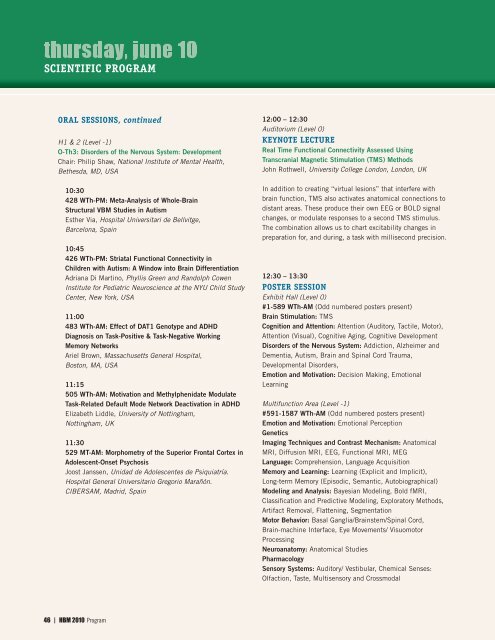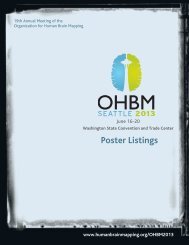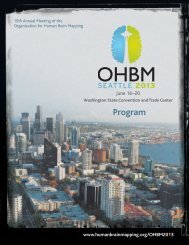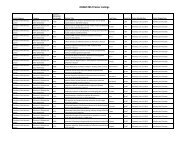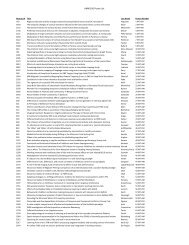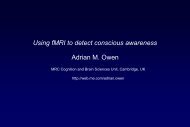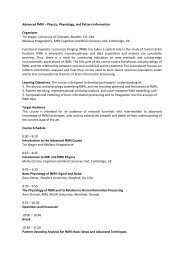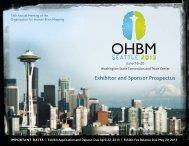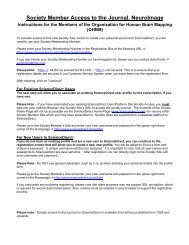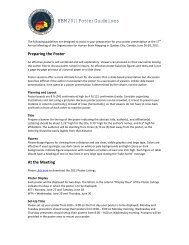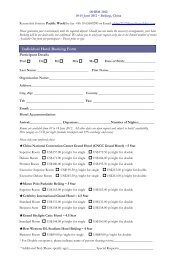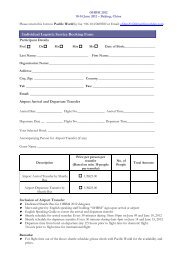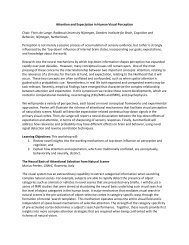HBM2010 - Organization for Human Brain Mapping
HBM2010 - Organization for Human Brain Mapping
HBM2010 - Organization for Human Brain Mapping
Create successful ePaper yourself
Turn your PDF publications into a flip-book with our unique Google optimized e-Paper software.
SCIENTIFIC PROGRAM<br />
ORAL SESSIONS, continued<br />
H1 & 2 (Level -1)<br />
O-Th3: Disorders of the Nervous System: Development<br />
Chair: Philip Shaw, National Institute of Mental Health,<br />
Bethesda, MD, USA<br />
10:30<br />
428 WTh-PM: Meta-Analysis of Whole-<strong>Brain</strong><br />
Structural VBM Studies in Autism<br />
Esther Via, Hospital Universitari de Bellvitge,<br />
Barcelona, Spain<br />
10:45<br />
426 WTh-PM: Striatal Functional Connectivity in<br />
Children with Autism: A Window into <strong>Brain</strong> Differentiation<br />
Adriana Di Martino, Phyllis Green and Randolph Cowen<br />
Institute <strong>for</strong> Pediatric Neuroscience at the NYU Child Study<br />
Center, New York, USA<br />
11:00<br />
483 WTh-AM: Effect of DAT1 Genotype and ADHD<br />
Diagnosis on Task-Positive & Task-Negative Working<br />
Memory Networks<br />
Ariel Brown, Massachusetts General Hospital,<br />
Boston, MA, USA<br />
11:15<br />
505 WTh-AM: Motivation and Methylphenidate Modulate<br />
Task-Related Default Mode Network Deactivation in ADHD<br />
Elizabeth Liddle, University of Nottingham,<br />
Nottingham, UK<br />
11:30<br />
529 MT-AM: Morphometry of the Superior Frontal Cortex in<br />
Adolescent-Onset Psychosis<br />
Joost Janssen, Unidad de Adolescentes de Psiquiatría.<br />
Hospital General Universitario Gregorio Marañón.<br />
CIBERSAM, Madrid, Spain<br />
12:00 – 12:30<br />
Auditorium (Level 0)<br />
KEYNOTE LECTURE<br />
Real Time Functional Connectivity Assessed Using<br />
Transcranial Magnetic Stimulation (TMS) Methods<br />
John Rothwell, University College London, London, UK<br />
In addition to creating “virtual lesions” that interfere with<br />
brain function, TMS also activates anatomical connections to<br />
distant areas. These produce their own EEG or BOLD signal<br />
changes, or modulate responses to a second TMS stimulus.<br />
The combination allows us to chart excitability changes in<br />
preparation <strong>for</strong>, and during, a task with millisecond precision.<br />
12:30 – 13:30<br />
POSTER SESSION<br />
Exhibit Hall (Level 0)<br />
#1-589 WTh-AM (Odd numbered posters present)<br />
<strong>Brain</strong> Stimulation: TMS<br />
Cognition and Attention: Attention (Auditory, Tactile, Motor),<br />
Attention (Visual), Cognitive Aging, Cognitive Development<br />
Disorders of the Nervous System: Addiction, Alzheimer and<br />
Dementia, Autism, <strong>Brain</strong> and Spinal Cord Trauma,<br />
Developmental Disorders,<br />
Emotion and Motivation: Decision Making, Emotional<br />
Learning<br />
Multifunction Area (Level -1)<br />
#591-1587 WTh-AM (Odd numbered posters present)<br />
Emotion and Motivation: Emotional Perception<br />
Genetics<br />
Imaging Techniques and Contrast Mechanism: Anatomical<br />
MRI, Diffusion MRI, EEG, Functional MRI, MEG<br />
Language: Comprehension, Language Acquisition<br />
Memory and Learning: Learning (Explicit and Implicit),<br />
Long-term Memory (Episodic, Semantic, Autobiographical)<br />
Modeling and Analysis: Bayesian Modeling, Bold fMRI,<br />
Classification and Predictive Modeling, Exploratory Methods,<br />
Artifact Removal, Flattening, Segmentation<br />
Motor Behavior: Basal Ganglia/<strong>Brain</strong>stem/Spinal Cord,<br />
<strong>Brain</strong>-machine Interface, Eye Movements/ Visuomotor<br />
Processing<br />
Neuroanatomy: Anatomical Studies<br />
Pharmacology<br />
Sensory Systems: Auditory/ Vestibular, Chemical Senses:<br />
Olfaction, Taste, Multisensory and Crossmodal<br />
46 | HBM 2010 Program


